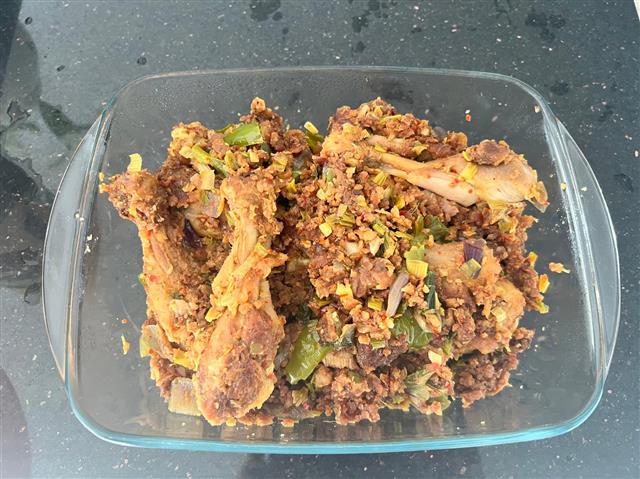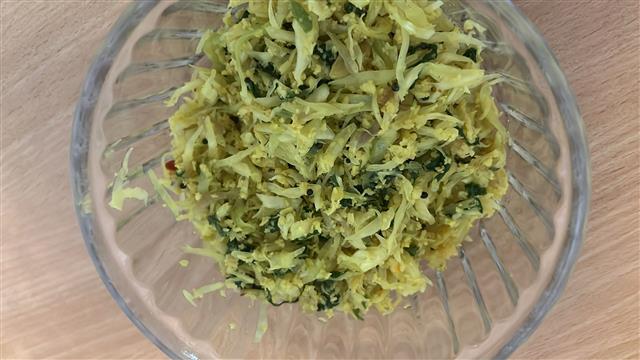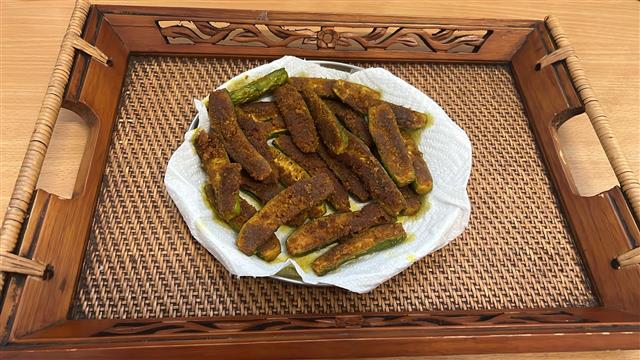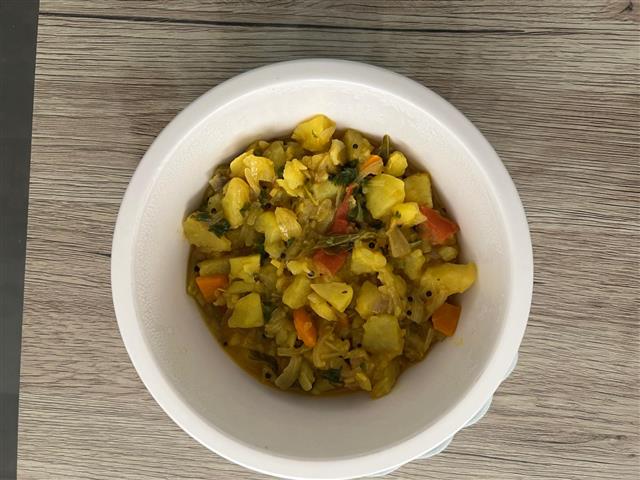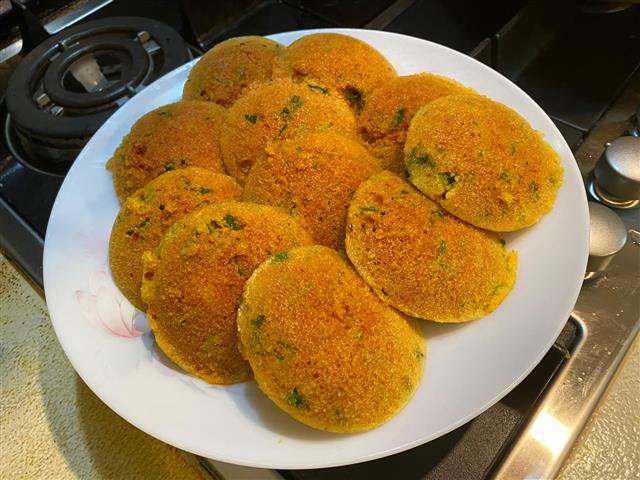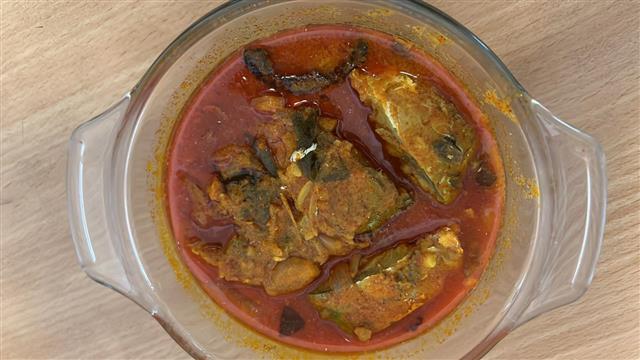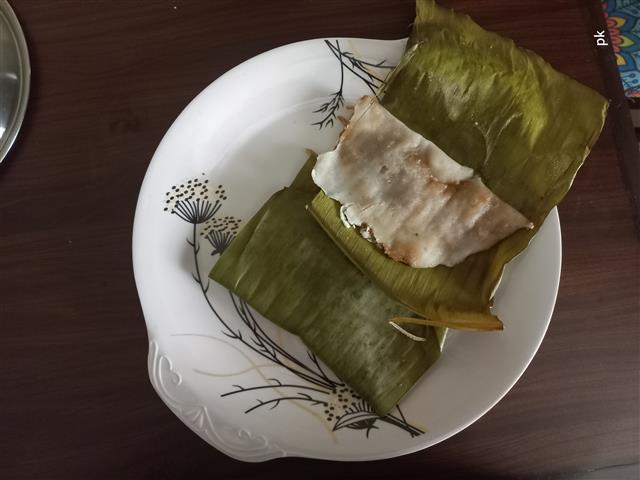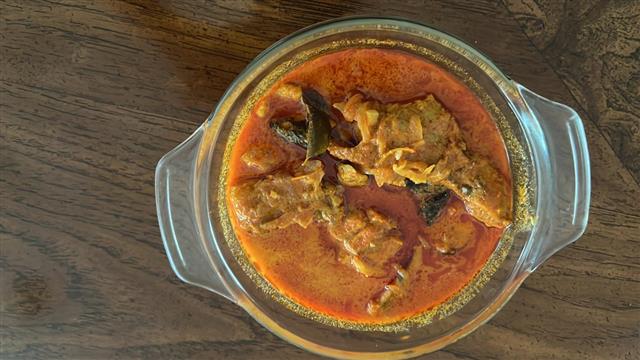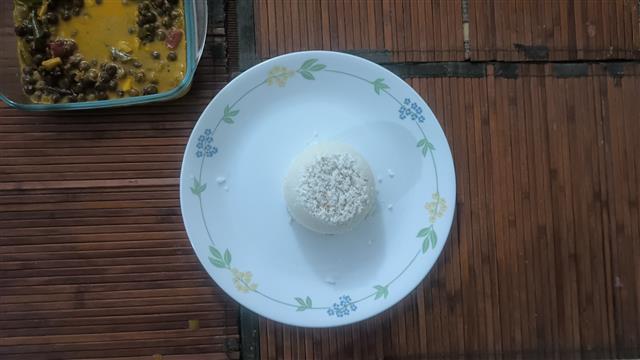
Chakkakuru Muringa Mango Curry
(4 reviews)
A tangy, earthy Kerala curry made with summer mangoes, jackfruit seeds and drumsticks.
Chakkakuru Muringa Mango Curry is another curd based curry with simple spices and a final tempering that enhances the tang.
A perfect accompaniment to rice and thoran on hot summer months, when jackfruit is in abundance.
Ingredients
Directions
- Remove 10-12 jackfruit seeds. Peel them and cut them in half. Cut the drumstick into 2-inch pieces. Cut half of the mango into small pieces.
- Cook the jackfruit seeds in a cooker with a pinch of salt in the pressure cooker for 1 whistle. When the jackfruit seeds are cooked, add turmeric powder, chilli powder, chopped mango and salt to the jackfruit seeds.
- Grind the coconut, cumin seeds, and shallots in a mixer with just enough water to make a smooth paste.
- Add this to the cooked vegetables. Add some curd to the vegetables.
- For the tempering, add oil to a small pan. Add mustard seeds, fenugreek seeds, chopped shallots and curry leaves. T
- Turn off the stove and add 1.5 tsp chilli powder to this tempering. Pour over the curry and serve.
Cooking Tips
• Peel jackfruit seeds: Soak in warm water for 10–15 minutes for easier peeling.
• Don't overcook drumsticks: They fall apart quickly; cook them until just tender.
• Curd tip: Always add curd and simmer on low flame to prevent curdling.
• Chilli powder in oil: Add after switching off the stove to avoid the ingredients from burning.
How to Serve
• With Steamed matta rice (red rice)
• With Dosa or appam for a lighter meal
• With Pappadam or banana chips for texture
• With Potato Mezhukkupuratti or Beetroot Thoran
• With Fish biryani or Chicken roast
The Story Behind Chakkakuru Muringa Mango Curry
This dish reminds me of the rainy afternoons when a pot of steaming red rice would be ready in the kitchen. Sun-dried jackfruit seeds would be stored to use in this curry. In the olden days, drumsticks and mangoes would be handpicked from the backyard trees. The curry was more than a recipe. It was a celebration of the monsoon season and the creative and frugal spirit of home cooks.
Jackfruit Drumstick Mango Curry has a gentle taste with bitter notes from chakkakuru, the slight astringency from muringakka, and mango with the sweetness with creaminess of coconut to round it up. A curry that doesn't draw attention with its ingredients or colours, but grows on you, sip by sip.
Jackfruit in rural Kerala isn't just a fruit. It's a mini event. The whole process, from cutting to portioning and storing, is almost ceremonial. Some parts of the fruit go into curries and turn into a vegetable side, others into chips or halwa, and the seeds are saved for special dishes like this one.
When dried or boiled and stored, chakkakuru becomes a year-round ingredient, especially when you want something filling and nostalgic.
What Is Chakkakuru Muringa Manga Curry?
It's a seasonal curry from Kerala that pairs three earthy ingredients—jackfruit seed, drumstick, and raw mango—in a coconut base. This vegetarian side dish is often served with kanji or steamed matta rice during the summer and early monsoon. The curry is mildly spiced and soured naturally with mango and the optional curd.
Regional Variations
Central Kerala: Some homes add a spoonful of cooked toor dal or moong dal to give it more body. Curd is often skipped here.
Malabar region: Instead of grinding shallots into the coconut paste, a few green chillies are added for heat. Shallots may only be used in the tempering.
Southern Kerala: A generous amount of curd is added for a tangier version. Sometimes even a little garlic goes into the coconut paste.
Tamil Nadu (Kongu-style): While not identical, similar mango-based curries are made with cooked legumes and raw banana. Drumsticks are commonly paired with tamarind-based gravies.
Sri Lankan Tamil kitchens: They may use jackfruit seeds in coconut milk-based gravies with curry powder and pandan leaf, though mango isn't often added.
Ingredient Spotlight
Raw Mango (Pacha Maanga)
Adds natural sourness without overpowering the dish. Rich in vitamin C and antioxidants. Cooling in nature and aids digestion. Choose firm, green mangoes with a slight sheen; avoid fibrous varieties.
Drumstick (Muringakka)
Brings a slightly pungent and drying note with a unique texture. Packed with iron, calcium, and vitamin C. Helps detoxify and boost immunity. Cook just until tender to avoid stringy bits in the curry.
Jackfruit Seed (Chakkakuru)
Nutty, starchy and meaty in texture. Full of fibre and excellent for gut health. Contains protein, zinc and magnesium.
How Is This Different from Pazha or Paccha Mango Curry?
While both curries feature mango and use a coconut base, Jackfruit Moringa Manga Curry is different in both flavour and texture.
Regular mango curry has mango as the star ingredient. Here, the mango is part of a trio alongside jackfruit seeds and drumsticks. Each plays an equal role to give the dish more body, texture, and taste.
Jackfruit seeds add a meaty and nutty texture to this curry, while muringakka (drumstick) adds its own aroma and texture that is often missing in mango-only curries.
Regular mango curries lean either sweet and tangy (when ripe mango is used) or tangy and sour (if using raw mango). The flavours in this curry are more complex. This side dish is heartier and thicker as well.
Pro Tips for Perfect Results
→ Use fresh coconut. This offers for the most authentic flavour.
→ Red chilli powder after switching off the flame. This ensures rich colour without burning.
→ Prep Jackfruit seeds: As these store well in the freezer after boiling, make ahead for faster prep.
→ Let the curry sit covered after tempering. It enhances the flavour.
Chakkakuru Muringa Mango Curry Variations
- No curd version
Simply skip curd and adjust the mango for sourness.
- With green chillies
For more heat, slit a green chilli and add while boiling veggies.
- With thoovara paruppu (toor dal)
In some households, a spoon of cooked dal is mixed in to thicken the curry.
Diet-Friendly Adaptations
Vegan: Use coconut or cashew based vegan curd.
Low-oil version: Use less coconut oil in the tempering.
No-onion version: Skip shallots entirely and focus on coconut-cumin base.
Storing & Reheating Tips
→ Fridge: Store in the fridge for 2 to 3 days in an airtight container.
→ Reheat: Heat gently in a pan. add a little water to thin it out if thickened.
→ Freeze: Do not freeze. Curd loses texture and becomes watery when thawed.
Common Mistakes to Avoid
→ Overcooking the seeds: One whistle is enough—overcooked chakkakuru turns rubbery.
→ Too much mango or coconut: It can overpower the curry and make it too tangy or too creamy.
→ Skipping the final chilli oil: That last bit of red oil adds colour, aroma, and heat
Frequently Asked Questions
- Can I use ripe mango instead of raw?
No, ripe mango will make it too sweet and ruin the balance of flavours.
- Is this dish spicy?
No, it's low-medium with a warm kick from the final tempering. You can decrease or increase chilli powder if needed.
- Can I make it ahead?
Yes! Boil the jackfruit in advance. Make the curry and add tempering just before serving for best taste.
- What can I use instead of drumsticks?
You can use raw banana, but the flavour will differ.
Equipment Needed
→ Saucepan or Mann Chatti – to cook the taro and curry
→ Knife and chopping board – to cut taro and onions
→ Frying Pan – For tempering the spices
→ Blender or Mixer Jar – To blend onions coconut and cumin seeds
→ Wooden Spoon – For gently stirring
